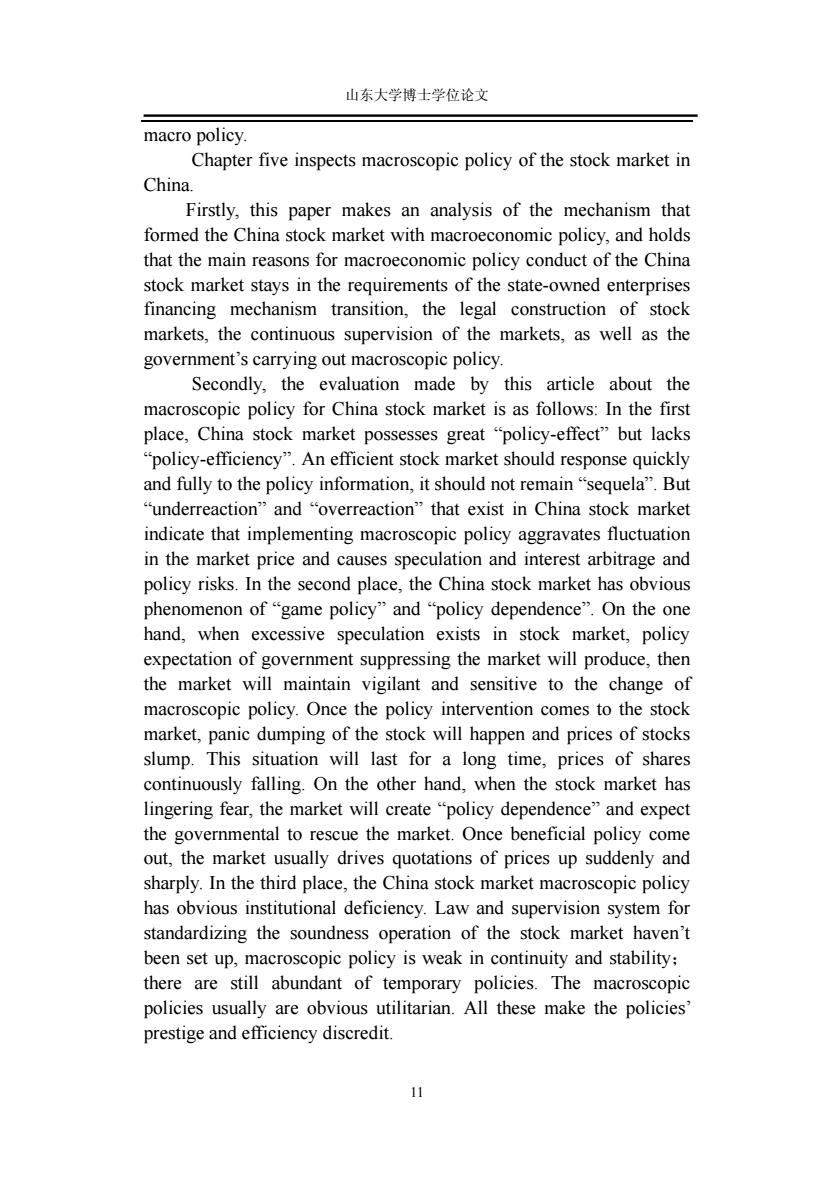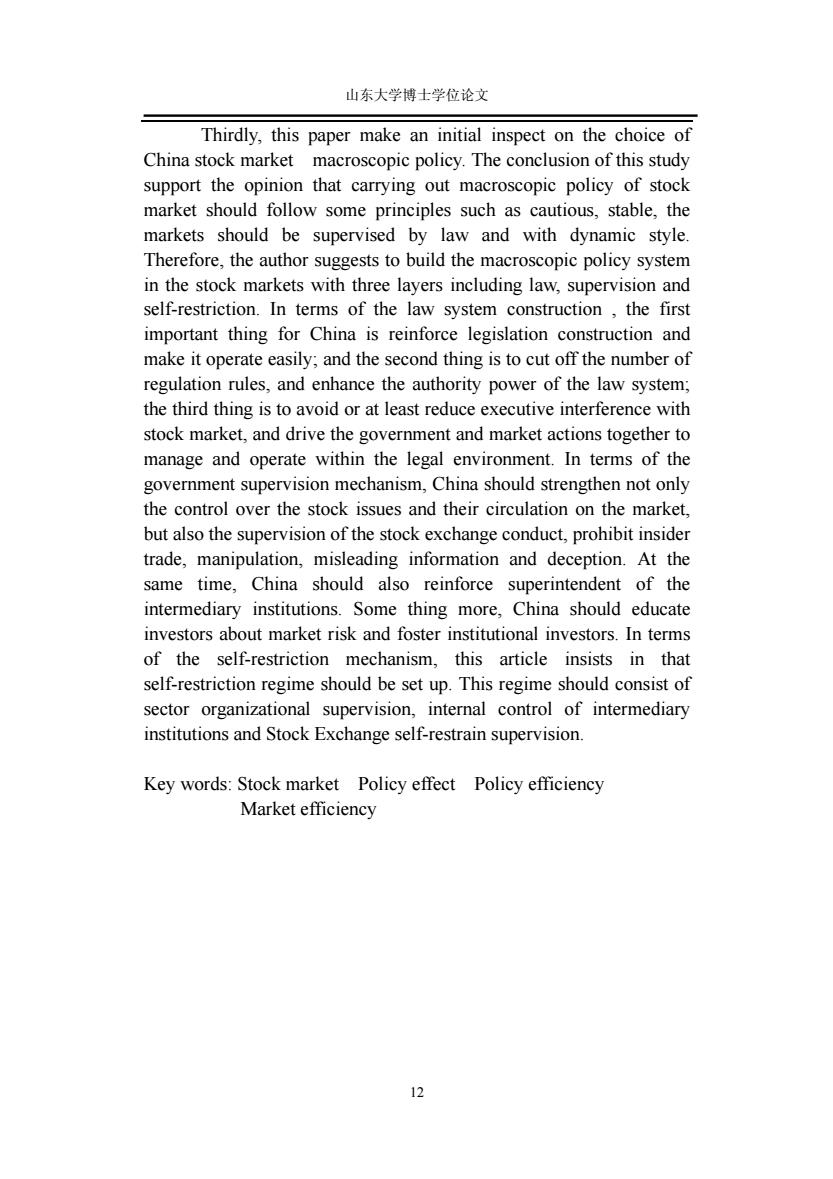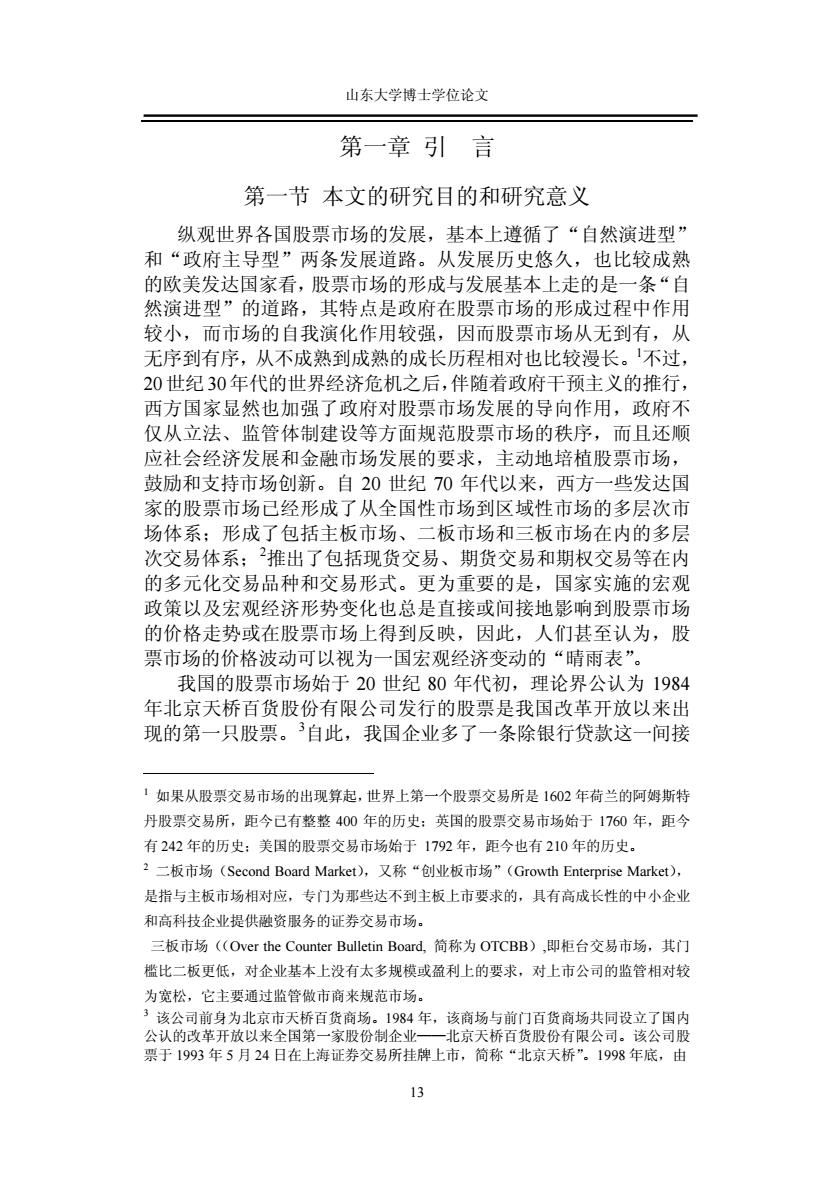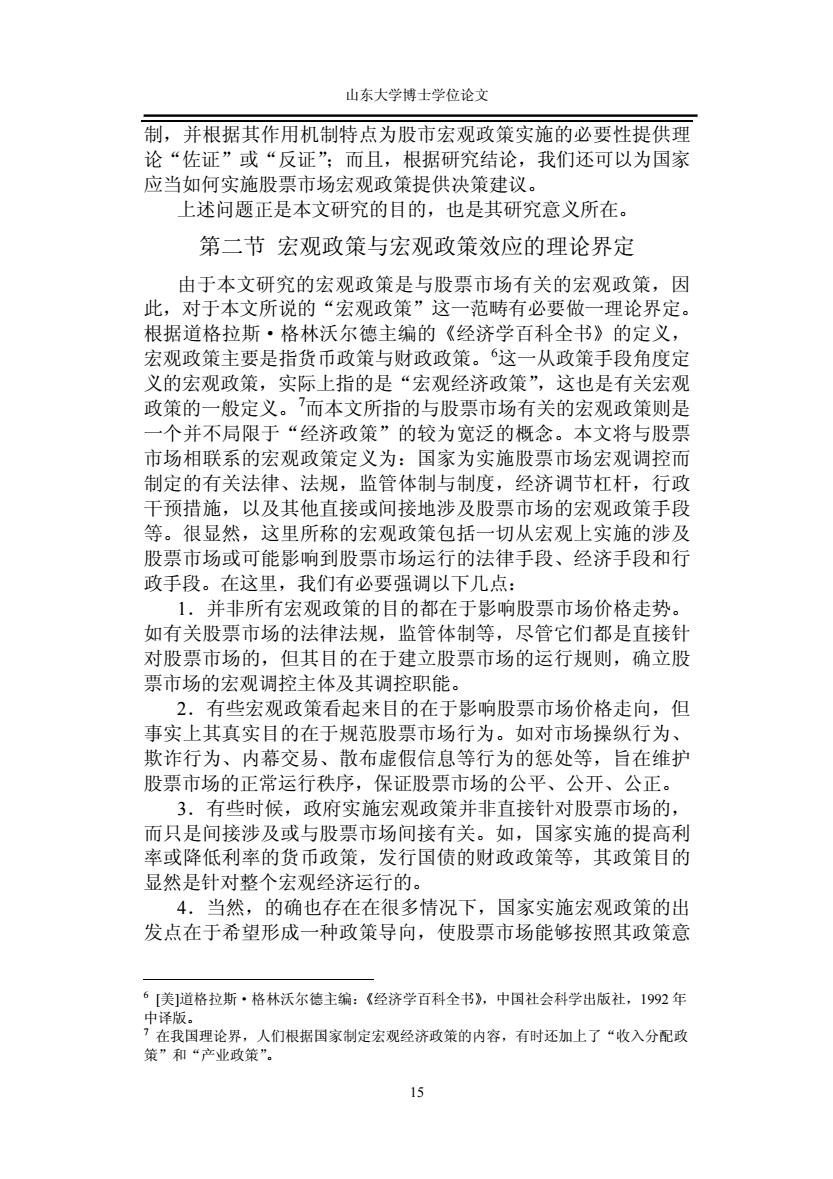
山东大学博士学位论文 macro policy. Chapter five inspects macroscopic policy of the stock market in China. Firstly,this paper makes an analysis of the mechanism that formed the China stock market with macroeconomic policy,and holds that the main reasons for macroeconomic policy conduct of the China stock market stays in the requirements of the state-owned enterprises financing mechanism transition,the legal construction of stock markets,the continuous supervision of the markets,as well as the government's carrying out macroscopic policy. Secondly,the evaluation made by this article about the macroscopic policy for China stock market is as follows:In the first place,China stock market possesses great "policy-effect"but lacks "policy-efficiency".An efficient stock market should response quickly and fully to the policy information,it should not remain "sequela".But underreaction”and“overreaction”that exist in China stock market indicate that implementing macroscopic policy aggravates fluctuation in the market price and causes speculation and interest arbitrage and policy risks.In the second place,the China stock market has obvious phenomenon of“game policy”and"policy dependence”.On the one hand,when excessive speculation exists in stock market,policy expectation of government suppressing the market will produce,then the market will maintain vigilant and sensitive to the change of macroscopic policy.Once the policy intervention comes to the stock market,panic dumping of the stock will happen and prices of stocks slump.This situation will last for a long time,prices of shares continuously falling.On the other hand,when the stock market has lingering fear,the market will create "policy dependence"and expect the governmental to rescue the market.Once beneficial policy come out,the market usually drives quotations of prices up suddenly and sharply.In the third place,the China stock market macroscopic policy has obvious institutional deficiency.Law and supervision system for standardizing the soundness operation of the stock market haven't been set up,macroscopic policy is weak in continuity and stability: there are still abundant of temporary policies.The macroscopic policies usually are obvious utilitarian.All these make the policies' prestige and efficiency discredit 11
山东大学博士学位论文 11 macro policy. Chapter five inspects macroscopic policy of the stock market in China. Firstly, this paper makes an analysis of the mechanism that formed the China stock market with macroeconomic policy, and holds that the main reasons for macroeconomic policy conduct of the China stock market stays in the requirements of the state-owned enterprises financing mechanism transition, the legal construction of stock markets, the continuous supervision of the markets, as well as the government’s carrying out macroscopic policy. Secondly, the evaluation made by this article about the macroscopic policy for China stock market is as follows: In the first place, China stock market possesses great “policy-effect” but lacks “policy-efficiency”. An efficient stock market should response quickly and fully to the policy information, it should not remain “sequela”. But “underreaction” and “overreaction” that exist in China stock market indicate that implementing macroscopic policy aggravates fluctuation in the market price and causes speculation and interest arbitrage and policy risks. In the second place, the China stock market has obvious phenomenon of “game policy” and “policy dependence”. On the one hand, when excessive speculation exists in stock market, policy expectation of government suppressing the market will produce, then the market will maintain vigilant and sensitive to the change of macroscopic policy. Once the policy intervention comes to the stock market, panic dumping of the stock will happen and prices of stocks slump. This situation will last for a long time, prices of shares continuously falling. On the other hand, when the stock market has lingering fear, the market will create “policy dependence” and expect the governmental to rescue the market. Once beneficial policy come out, the market usually drives quotations of prices up suddenly and sharply. In the third place, the China stock market macroscopic policy has obvious institutional deficiency. Law and supervision system for standardizing the soundness operation of the stock market haven’t been set up, macroscopic policy is weak in continuity and stability; there are still abundant of temporary policies. The macroscopic policies usually are obvious utilitarian. All these make the policies’ prestige and efficiency discredit

山东大学博士学位论文 Thirdly,this paper make an initial inspect on the choice of China stock market macroscopic policy.The conclusion of this study support the opinion that carrying out macroscopic policy of stock market should follow some principles such as cautious,stable,the markets should be supervised by law and with dynamic style. Therefore,the author suggests to build the macroscopic policy system in the stock markets with three layers including law,supervision and self-restriction.In terms of the law system construction,the first important thing for China is reinforce legislation construction and make it operate easily;and the second thing is to cut off the number of regulation rules,and enhance the authority power of the law system; the third thing is to avoid or at least reduce executive interference with stock market,and drive the government and market actions together to manage and operate within the legal environment.In terms of the government supervision mechanism,China should strengthen not only the control over the stock issues and their circulation on the market, but also the supervision of the stock exchange conduct,prohibit insider trade,manipulation,misleading information and deception.At the same time,China should also reinforce superintendent of the intermediary institutions.Some thing more,China should educate investors about market risk and foster institutional investors.In terms of the self-restriction mechanism,this article insists in that self-restriction regime should be set up.This regime should consist of sector organizational supervision,internal control of intermediary institutions and Stock Exchange self-restrain supervision. Key words:Stock market Policy effect Policy efficiency Market efficiency 12
山东大学博士学位论文 12 Thirdly, this paper make an initial inspect on the choice of China stock market macroscopic policy. The conclusion of this study support the opinion that carrying out macroscopic policy of stock market should follow some principles such as cautious, stable, the markets should be supervised by law and with dynamic style. Therefore, the author suggests to build the macroscopic policy system in the stock markets with three layers including law, supervision and self-restriction. In terms of the law system construction , the first important thing for China is reinforce legislation construction and make it operate easily; and the second thing is to cut off the number of regulation rules, and enhance the authority power of the law system; the third thing is to avoid or at least reduce executive interference with stock market, and drive the government and market actions together to manage and operate within the legal environment. In terms of the government supervision mechanism, China should strengthen not only the control over the stock issues and their circulation on the market, but also the supervision of the stock exchange conduct, prohibit insider trade, manipulation, misleading information and deception. At the same time, China should also reinforce superintendent of the intermediary institutions. Some thing more, China should educate investors about market risk and foster institutional investors. In terms of the self-restriction mechanism, this article insists in that self-restriction regime should be set up. This regime should consist of sector organizational supervision, internal control of intermediary institutions and Stock Exchange self-restrain supervision. Key words: Stock market Policy effect Policy efficiency Market efficiency

山东大学博士学位论文 第一章引言 第一节本文的研究目的和研究意义 纵观世界各国股票市场的发展,基本上遵循了“自然演进型” 和“政府主导型”两条发展道路。从发展历史悠久,也比较成熟 的欧美发达国家看,股票市场的形成与发展基本上走的是一条“自 然演进型”的道路,其特点是政府在股票市场的形成过程中作用 较小,而市场的自我演化作用较强,因而股票市场从无到有,从 无序到有序,从不成熟到成熟的成长历程相对也比较漫长。不过, 20世纪30年代的世界经济危机之后,伴随着政府干预主义的推行, 西方国家显然也加强了政府对股票市场发展的导向作用,政府不 仅从立法、监管体制建设等方面规范股票市场的秩序,而且还顺 应社会经济发展和金融市场发展的要求,主动地培植股票市场, 鼓励和支持市场创新。自20世纪70年代以来,西方一些发达国 家的股票市场己经形成了从全国性市场到区域性市场的多层次市 场体系:形成了包括主板市场、二板市场和三板市场在内的多层 次交易体系:2推出了包括现货交易、期货交易和期权交易等在内 的多元化交易品种和交易形式。更为重要的是,国家实施的宏观 政策以及宏观经济形势变化也总是直接或间接地影响到股票市场 的价格走势或在股票市场上得到反映,因此,人们甚至认为,股 票市场的价格波动可以视为一国宏观经济变动的“晴雨表”。 我国的股票市场始于20世纪80年代初,理论界公认为1984 年北京天桥百货股份有限公司发行的股票是我国改革开放以来出 现的第一只股票。3自此,我国企业多了一条除银行贷款这一间接 1如果从股票交易市场的出现算起,世界上第一个股票交易所是1602年荷兰的阿姆斯特 丹股票交易所,距今己有整整400年的历史:英国的股票交易市场始于1760年,距今 有242年的历史:美国的股票交易市场始于1792年,距今也有210年的历史。 2二板市场(Second Board Market).,又称“创y业板市场”(Growth Enterprise Market), 是指与主板市场相对应,专门为那些达不到主板上市要求的,具有高成长性的中小企业 和高科技企业提供融资服务的证券交易市场。 三板市场(Over the Counter Bulletin Board,简称为OTCBB),即柜台交易市场,其门 槛比二板更低,对企业基本上没有太多规模或盈利上的要求,对上市公司的监管相对较 为宽松,它主要通过监管做市商来规范市场。 3该公司前身为北京市天桥百货商场。1984年,该商场与前门百货商场共同设立了国内 公认的改革开放以来全国第一家股份制企业一北京天桥百货股份有限公司。该公司股 票于1993年5月24日在上海证券交易所挂牌上市,简称“北京天桥”。1998年底,由 13
山东大学博士学位论文 13 第一章 引 言 第一节 本文的研究目的和研究意义 纵观世界各国股票市场的发展,基本上遵循了“自然演进型” 和“政府主导型”两条发展道路。从发展历史悠久,也比较成熟 的欧美发达国家看,股票市场的形成与发展基本上走的是一条“自 然演进型”的道路,其特点是政府在股票市场的形成过程中作用 较小,而市场的自我演化作用较强,因而股票市场从无到有,从 无序到有序,从不成熟到成熟的成长历程相对也比较漫长。1 不过, 20世纪30年代的世界经济危机之后,伴随着政府干预主义的推行, 西方国家显然也加强了政府对股票市场发展的导向作用,政府不 仅从立法、监管体制建设等方面规范股票市场的秩序,而且还顺 应社会经济发展和金融市场发展的要求,主动地培植股票市场, 鼓励和支持市场创新。自 20 世纪 70 年代以来,西方一些发达国 家的股票市场已经形成了从全国性市场到区域性市场的多层次市 场体系;形成了包括主板市场、二板市场和三板市场在内的多层 次交易体系;2 推出了包括现货交易、期货交易和期权交易等在内 的多元化交易品种和交易形式。更为重要的是,国家实施的宏观 政策以及宏观经济形势变化也总是直接或间接地影响到股票市场 的价格走势或在股票市场上得到反映,因此,人们甚至认为,股 票市场的价格波动可以视为一国宏观经济变动的“晴雨表”。 我国的股票市场始于 20 世纪 80 年代初,理论界公认为 1984 年北京天桥百货股份有限公司发行的股票是我国改革开放以来出 现的第一只股票。3 自此,我国企业多了一条除银行贷款这一间接 1 如果从股票交易市场的出现算起,世界上第一个股票交易所是 1602 年荷兰的阿姆斯特 丹股票交易所,距今已有整整 400 年的历史;英国的股票交易市场始于 1760 年,距今 有 242 年的历史;美国的股票交易市场始于 1792 年,距今也有 210 年的历史。 2 二板市场(Second Board Market),又称“创业板市场”(Growth Enterprise Market), 是指与主板市场相对应,专门为那些达不到主板上市要求的,具有高成长性的中小企业 和高科技企业提供融资服务的证券交易市场。 三板市场((Over the Counter Bulletin Board, 简称为 OTCBB),即柜台交易市场,其门 槛比二板更低,对企业基本上没有太多规模或盈利上的要求,对上市公司的监管相对较 为宽松,它主要通过监管做市商来规范市场。 3 该公司前身为北京市天桥百货商场。1984 年,该商场与前门百货商场共同设立了国内 公认的改革开放以来全国第一家股份制企业——北京天桥百货股份有限公司。该公司股 票于 1993 年 5 月 24 日在上海证券交易所挂牌上市,简称“北京天桥”。1998 年底,由

山东大学博士学位论文 融资之外的股票直接融资渠道。20世纪90年代初,随着上海证券 交易所和深圳证券交易所的成立,一个包括股票发行市场和流通 市场在内的完整的股票市场形成了,发行股票和股票上市也越来 越成为联结企业改制和实现企业融资机制转换的一个非常重要的 手段。从1990年底上海证券交易所挂牌8家上市公司算起,4到 2001年底短短11年的时间里,上海、深圳两家证券交易所上市公 司(包括A、B股)发展到1160家,市价总值达4.35万亿元,开户投 资者达到6650万户。5股票市场已经成为我国资本市场最重要的组 成部分,股票投资也名副其实地成为一种大众化的投资工具: 从我国股票市场不长的发展历史看,除在股票发行市场发展初 期带有一定的民间自发性外,其整个发展过程都是在政府的引导 和推动下成长起来的,走的是一条典型的“政府主导型”发展道 路,其特点是发展速度较快。这正是我国股票市场之所以能在较 短的时间内达到现在这样的规模的重要原因。 股票市场建立后,为了保证市场的健康有序发展,一方面,政 府需要建立并不断完善规范市场行为的法律、法规体系以及监管 体制,完成股票市场基本运作规则和基本制度的建构:另一方面, 面对新兴市场上普遍存在的各种不规范行为,如过度投机、庄家 操纵、内幕交易、市场欺诈、虚假陈述、散布虚假信息等,政府 还要依据上述法律法规,发挥监管职能,建立股票市场的动态调 控机制,维护股票市场的正常运行秩序。此外,值得注意的是, 股票市场作为联结市场与企业,联结微观经济运行与宏观经济发 展的结合点,我国政府还有意识地将股票市场作为贯彻国家宏观 政策意图的导向窗口,经常地对股票市场实施政策干预。为此, 对于我国的股票市场,人们普遍地称之为“政策市”,认为我国股 票市场的运行和价格走势主要取决于政府“意愿”,而非市场“意 愿”。 从这里,我们自然地引申出这样一个问题,即:我国的宏观政 策是否真的可以左右股票市场的运行?它在多大程度上影响着股 票市场的运行?又是如何影响股票市场运行的?换一句话说,我 国股票市场的宏观政策效应如何? 研究这一问题具有非常重要的理论意义和政策意义。通过研 究,我们不仅可以一般地揭示我国宏观政策对股票市场的作用机 于北大青鸟入主北京天桥,公司易名“青鸟天桥”。 41990年12月19日,上海证券交易所正式挂牌营业,延中实业、真空电子、飞乐音响、 爱使股份、申华实业、飞乐股份、豫园商城和浙江凤凰8只股票成为首批上市股票,俗 称“老八股”。目前,老八股中多数己经易主。 S中国证券监督管理委员会网站htp:www.csrc.gov.cn。 14
山东大学博士学位论文 14 融资之外的股票直接融资渠道。20 世纪 90 年代初,随着上海证券 交易所和深圳证券交易所的成立,一个包括股票发行市场和流通 市场在内的完整的股票市场形成了,发行股票和股票上市也越来 越成为联结企业改制和实现企业融资机制转换的一个非常重要的 手段。从 1990 年底上海证券交易所挂牌 8 家上市公司算起,4 到 2001 年底短短 11 年的时间里,上海、深圳两家证券交易所上市公 司(包括A、B股)发展到 1160 家,市价总值达 4.35 万亿元,开户投 资者达到 6650 万户。5 股票市场已经成为我国资本市场最重要的组 成部分,股票投资也名副其实地成为一种大众化的投资工具。 从我国股票市场不长的发展历史看,除在股票发行市场发展初 期带有一定的民间自发性外,其整个发展过程都是在政府的引导 和推动下成长起来的,走的是一条典型的“政府主导型”发展道 路,其特点是发展速度较快。这正是我国股票市场之所以能在较 短的时间内达到现在这样的规模的重要原因。 股票市场建立后,为了保证市场的健康有序发展,一方面,政 府需要建立并不断完善规范市场行为的法律、法规体系以及监管 体制,完成股票市场基本运作规则和基本制度的建构;另一方面, 面对新兴市场上普遍存在的各种不规范行为,如过度投机、庄家 操纵、内幕交易、市场欺诈、虚假陈述、散布虚假信息等,政府 还要依据上述法律法规,发挥监管职能,建立股票市场的动态调 控机制,维护股票市场的正常运行秩序。此外,值得注意的是, 股票市场作为联结市场与企业,联结微观经济运行与宏观经济发 展的结合点,我国政府还有意识地将股票市场作为贯彻国家宏观 政策意图的导向窗口,经常地对股票市场实施政策干预。为此, 对于我国的股票市场,人们普遍地称之为“政策市”,认为我国股 票市场的运行和价格走势主要取决于政府“意愿”,而非市场“意 愿”。 从这里,我们自然地引申出这样一个问题,即:我国的宏观政 策是否真的可以左右股票市场的运行?它在多大程度上影响着股 票市场的运行?又是如何影响股票市场运行的?换一句话说,我 国股票市场的宏观政策效应如何? 研究这一问题具有非常重要的理论意义和政策意义。通过研 究,我们不仅可以一般地揭示我国宏观政策对股票市场的作用机 于北大青鸟入主北京天桥,公司易名“青鸟天桥”。 4 1990 年 12 月 19 日,上海证券交易所正式挂牌营业,延中实业、真空电子、飞乐音响、 爱使股份、申华实业、飞乐股份、豫园商城和浙江凤凰 8 只股票成为首批上市股票,俗 称“老八股”。目前,老八股中多数已经易主。 5 中国证券监督管理委员会网站 http://www.csrc.gov.cn

山东大学博士学位论文 制,并根据其作用机制特点为股市宏观政策实施的必要性提供理 论“佐证”或“反证”:而且,根据研究结论,我们还可以为国家 应当如何实施股票市场宏观政策提供决策建议。 上述问题正是本文研究的目的,也是其研究意义所在。 第二节宏观政策与宏观政策效应的理论界定 由于本文研究的宏观政策是与股票市场有关的宏观政策,因 此,对于本文所说的“宏观政策”这一范畴有必要做一理论界定。 根据道格拉斯·格林沃尔德主编的《经济学百科全书》的定义, 宏观政策主要是指货币政策与财政政策。6这一从政策手段角度定 义的宏观政策,实际上指的是“宏观经济政策”,这也是有关宏观 政策的一般定义。而本文所指的与股票市场有关的宏观政策则是 一个并不局限于“经济政策”的较为宽泛的概念。本文将与股票 市场相联系的宏观政策定义为:国家为实施股票市场宏观调控而 制定的有关法律、法规,监管体制与制度,经济调节杠杆,行政 干预措施,以及其他直接或间接地涉及股票市场的宏观政策手段 等。很显然,这里所称的宏观政策包括一切从宏观上实施的涉及 股票市场或可能影响到股票市场运行的法律手段、经济手段和行 政手段。在这里,我们有必要强调以下几点: 1.并非所有宏观政策的目的都在于影响股票市场价格走势。 如有关股票市场的法律法规,监管体制等,尽管它们都是直接针 对股票市场的,但其目的在于建立股票市场的运行规则,确立股 票市场的宏观调控主体及其调控职能。 2.有些宏观政策看起来目的在于影响股票市场价格走向,但 事实上其真实目的在于规范股票市场行为。如对市场操纵行为、 欺诈行为、内幕交易、散布虚假信息等行为的惩处等,旨在维护 股票市场的正常运行秩序,保证股票市场的公平、公开、公正。 3.有些时候,政府实施宏观政策并非直接针对股票市场的, 而只是间接涉及或与股票市场间接有关。如,国家实施的提高利 率或降低利率的货币政策,发行国债的财政政策等,其政策目的 显然是针对整个宏观经济运行的。 4.当然,的确也存在在很多情况下,国家实施宏观政策的出 发点在于希望形成一种政策导向,使股票市场能够按照其政策意 6[美]道格拉斯·格林沃尔德主编:《经济学百科全书》,中国社会科学出版社,1992年 中译版。 ?在我国理论界,人们根据国家制定宏观经济政策的内容,有时还加上了“收入分配政 策”和“产业政策”。 15
山东大学博士学位论文 15 制,并根据其作用机制特点为股市宏观政策实施的必要性提供理 论“佐证”或“反证”;而且,根据研究结论,我们还可以为国家 应当如何实施股票市场宏观政策提供决策建议。 上述问题正是本文研究的目的,也是其研究意义所在。 第二节 宏观政策与宏观政策效应的理论界定 由于本文研究的宏观政策是与股票市场有关的宏观政策,因 此,对于本文所说的“宏观政策”这一范畴有必要做一理论界定。 根据道格拉斯·格林沃尔德主编的《经济学百科全书》的定义, 宏观政策主要是指货币政策与财政政策。6 这一从政策手段角度定 义的宏观政策,实际上指的是“宏观经济政策”,这也是有关宏观 政策的一般定义。7 而本文所指的与股票市场有关的宏观政策则是 一个并不局限于“经济政策”的较为宽泛的概念。本文将与股票 市场相联系的宏观政策定义为:国家为实施股票市场宏观调控而 制定的有关法律、法规,监管体制与制度,经济调节杠杆,行政 干预措施,以及其他直接或间接地涉及股票市场的宏观政策手段 等。很显然,这里所称的宏观政策包括一切从宏观上实施的涉及 股票市场或可能影响到股票市场运行的法律手段、经济手段和行 政手段。在这里,我们有必要强调以下几点: 1.并非所有宏观政策的目的都在于影响股票市场价格走势。 如有关股票市场的法律法规,监管体制等,尽管它们都是直接针 对股票市场的,但其目的在于建立股票市场的运行规则,确立股 票市场的宏观调控主体及其调控职能。 2.有些宏观政策看起来目的在于影响股票市场价格走向,但 事实上其真实目的在于规范股票市场行为。如对市场操纵行为、 欺诈行为、内幕交易、散布虚假信息等行为的惩处等,旨在维护 股票市场的正常运行秩序,保证股票市场的公平、公开、公正。 3.有些时候,政府实施宏观政策并非直接针对股票市场的, 而只是间接涉及或与股票市场间接有关。如,国家实施的提高利 率或降低利率的货币政策,发行国债的财政政策等,其政策目的 显然是针对整个宏观经济运行的。 4.当然,的确也存在在很多情况下,国家实施宏观政策的出 发点在于希望形成一种政策导向,使股票市场能够按照其政策意 6 [美]道格拉斯·格林沃尔德主编:《经济学百科全书》,中国社会科学出版社,1992 年 中译版。 7 在我国理论界,人们根据国家制定宏观经济政策的内容,有时还加上了“收入分配政 策”和“产业政策